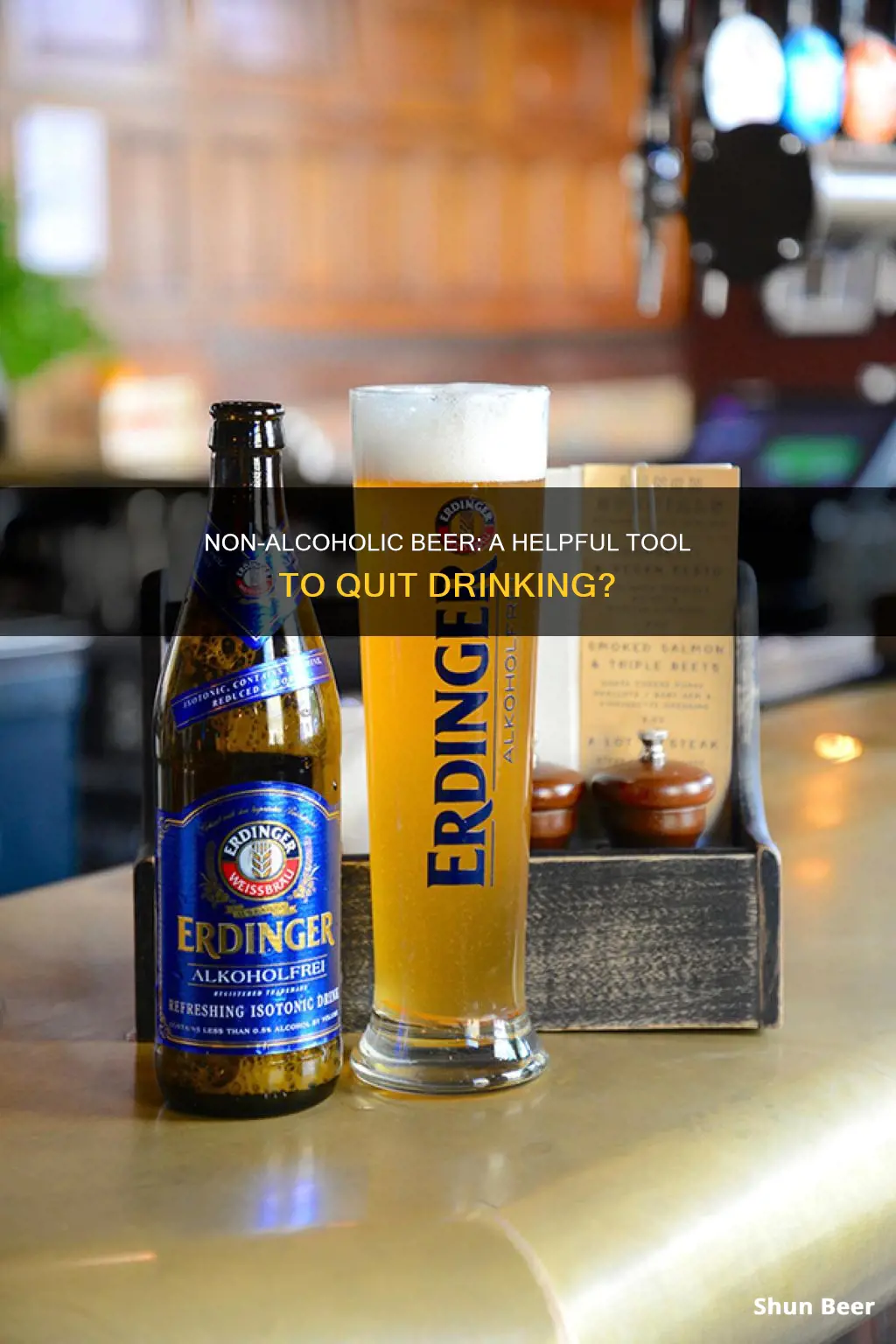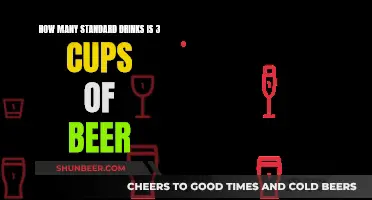
Non-alcoholic beer has become a popular alternative for those looking to cut down on their alcohol consumption or quit drinking altogether. While it offers a way to enjoy the taste and social experience of drinking beer without the intoxicating effects, its effectiveness in helping alcoholics stop drinking is a subject of debate. Some argue that it provides a valuable tool for moderating alcohol intake, while others believe it poses a risk of triggering cravings and leading to relapse. The decision to consume non-alcoholic beer during recovery depends on individual circumstances, motivations, and triggers, with varying perspectives among recovering alcoholics and sobriety coaches.
| Characteristics | Values |
|---|---|
| Alcohol content | Non-alcoholic beer typically contains 0.5% or less of alcohol by volume (ABV). |
| Benefits | Provides a safe alternative to consuming alcohol; allows individuals to navigate social situations without feeling left out or pressured to drink; can be part of an overall mindful approach to recovery; may help individuals feel included and normal. |
| Risks | May trigger cravings and lead to unwanted binge drinking; may not be advisable for everyone trying to overcome an alcohol problem; may trigger a relapse in some individuals; may contain more alcohol than indicated on the label. |
| Effectiveness | There is no one-size-fits-all solution; effectiveness depends on individual circumstances, the nature of the relationship with alcohol, and personal goals. |
What You'll Learn
- Non-alcoholic beer may trigger cravings and lead to binge drinking
- It can be a valuable alternative for people looking to moderate their alcohol intake
- It can help people feel included in social situations without compromising their sobriety
- It may trigger a relapse in some individuals
- It can be a slippery slope that leads back to drinking alcoholic beverages

Non-alcoholic beer may trigger cravings and lead to binge drinking
Non-alcoholic beer is often presented as a safe alternative to alcoholic drinks, but it may not be the best option for people with alcohol use problems. While it can be beneficial for those looking to reduce their alcohol intake, it may also trigger cravings and lead to binge drinking for those recovering from alcohol addiction.
The smell and taste of non-alcoholic beer can be powerful triggers for people with alcohol use disorder. The anticipation of alcohol consumption can increase dopamine levels in the brain, enhancing feelings of elation and pleasure. This can lead to cravings and a subsequent relapse. In fact, statistics show that up to 90% of alcoholics will experience a relapse within four years of quitting drinking.
The placebo effect also comes into play with non-alcoholic drinks. The act of consuming a beverage that resembles beer can trigger sensations and emotions associated with alcohol consumption, potentially disrupting an individual's sobriety journey.
Additionally, non-alcoholic beer may contain small amounts of alcohol, with some products containing up to 0.5% alcohol by volume (ABV). This can be risky for people in recovery, as even trace amounts of alcohol can stimulate the reward centres of the brain and trigger cravings.
For these reasons, it is crucial for individuals in recovery to assess their own triggers and consult with healthcare professionals or support groups to determine if non-alcoholic beer is suitable for their journey towards sobriety. While it may be a helpful tool for some, it is essential to recognise the potential risks and make an informed decision.
Craft Beer Festivals: All-You-Can-Drink Events?
You may want to see also

It can be a valuable alternative for people looking to moderate their alcohol intake
Non-alcoholic beer has gained popularity as a valuable alternative for people looking to moderate their alcohol intake. It offers an option for those who want to enjoy the taste and social experience of drinking without the intoxicating effects of alcohol. This can be especially beneficial for individuals in recovery from alcohol addiction, as it provides a sense of normalcy and inclusivity in social situations where alcohol is present.
For some, non-alcoholic beer can be a tool to navigate social gatherings without feeling left out or pressured to consume alcoholic beverages. It can also be a way to address their addiction gradually, as complete abstinence may feel too overwhelming at first. By choosing non-alcoholic options, individuals can begin to restrict their drinking and work towards their goal of sobriety.
Additionally, non-alcoholic beers are often made from natural ingredients and have fewer preservatives and added sugars than their alcoholic counterparts. This makes them a healthier alternative for those concerned about their well-being.
However, it is important to note that non-alcoholic beer is not a one-size-fits-all solution. While it can be beneficial for some, it may trigger cravings and lead to unwanted binge drinking for others. The decision to consume non-alcoholic beer depends on individual circumstances, the nature of one's relationship with alcohol, and the progress in their recovery journey.
To make an informed choice, it is advisable to consult with healthcare professionals or support groups. They can provide guidance and help individuals assess their physical and emotional triggers to determine if non-alcoholic beer aligns with their definition of sobriety and their long-term recovery goals.
Jehovah's Witnesses and Alcohol: Beer Included?
You may want to see also

It can help people feel included in social situations without compromising their sobriety
For many recovering alcoholics, non-alcoholic beer can be a valuable tool to navigate social situations where alcohol is present. It allows them to participate in social gatherings without feeling left out or pressured to consume alcoholic drinks. It provides a sense of normalcy and inclusivity, enabling individuals to enjoy the taste and experience of beer while maintaining their commitment to sobriety.
Non-alcoholic drinks can make social settings feel more inclusive. They can help people feel comfortable participating in social events without feeling awkward, out of place, or pressured to drink. This can be especially important for those in recovery from alcohol addiction, as it allows them to blend in and feel included without compromising their sobriety.
Non-alcoholic beer can be a way for recovering alcoholics to feel included in social situations where alcohol is typically consumed, such as at bars or restaurants. It can help them avoid feeling awkward or excluded when others are drinking, and it can also provide a sense of normalcy and help them feel like they are not missing out. For example, an individual in recovery can order a non-alcoholic beer at a bar instead of a regular beer, allowing them to still enjoy the taste and sensation of drinking beer without consuming alcohol.
In addition, non-alcoholic drinks can be a safe alternative to consuming alcohol when cravings or urges for a drink arise. They can help individuals navigate these cravings without taking a drink, which can aid in reducing overall alcohol consumption or achieving complete abstinence. Non-alcoholic drinks can mimic certain aspects of drinking without exposing individuals to the negative consequences associated with heavy drinking.
However, it is important to note that non-alcoholic drinks may not be suitable for everyone in recovery. For some, the taste, smell, or ritual of drinking non-alcoholic beer may trigger cravings or emotional associations with alcohol, potentially leading to a relapse. It is crucial for individuals in recovery to assess their own triggers and consult with healthcare professionals or support groups to determine if non-alcoholic drinks are a safe choice for their journey towards sobriety.
Beer and Prozac: What You Need to Know
You may want to see also

It may trigger a relapse in some individuals
The use of non-alcoholic drinks can be a controversial topic in recovery communities. While some individuals in recovery find that non-alcoholic beer helps them feel included in social situations, others believe that it may trigger cravings and lead to a relapse.
The smell, taste, and appearance of non-alcoholic beer are very similar to those of regular beer. For some individuals with alcohol use disorder, the smell of beer alone may be enough to trigger cravings and a subsequent relapse. Research supports this, as a team of California scientists reported that the smell of alcohol may be enough to trigger cravings and a subsequent relapse among certain people with alcohol use disorder. In their study, rats were trained to self-administer alcohol when they smelled a particular scent. The researchers found increases in dopamine in the rats' brains before and after smelling these "alcohol-related cues". While this was an animal study, it suggests that similar effects could occur in humans.
Another concern is that non-alcoholic drinks may contain small amounts of alcohol. According to federal law in the United States, for a beverage to be considered non-alcoholic, it must contain 0.5% or less alcohol by volume (ABV). However, a recent study found that 29% of non-alcoholic beverages had higher alcohol levels than indicated on their labels. For individuals in recovery who are trying to avoid alcohol completely, even these small amounts of alcohol may be triggering.
Additionally, the act of consuming a beverage that resembles beer can trigger a placebo response, leading individuals to experience sensations or emotions similar to those associated with alcohol consumption. This can have both positive and negative effects, depending on the individual's mindset and intentions. For some, the "placebo effect" of intoxication may lead to a dangerous craving for more.
Ultimately, the decision to consume non-alcoholic beer during recovery depends on individual circumstances and the nature of one's relationship with alcohol. It is crucial for individuals in recovery to evaluate their own triggers and consult with healthcare professionals or support groups to determine if non-alcoholic beer is a suitable choice for their journey.
Old Beer: Is It Safe to Drink After a Year?
You may want to see also

It can be a slippery slope that leads back to drinking alcoholic beverages
The idea of consuming non-alcoholic drinks as a substitute for alcoholic beverages has gained traction in recent years, with many people becoming "sober curious" and wanting to explore the benefits of abstaining from alcohol. However, the question of whether non-alcoholic beer can help alcoholics stop drinking is complex and has sparked debates in the recovery community. While some people view it as a valuable tool in their recovery journey, others consider it a potential trigger that can lead to a slippery slope back to drinking alcoholic beverages.
The "slippery slope" argument against non-alcoholic beer is based on several factors. Firstly, the taste and aroma of non-alcoholic beer are very similar to those of regular beer. This sensory experience can trigger "euphoric recall" in recovering alcoholics, leading them to romanticize their previous drinking habits and forget the negative consequences of their addiction. The act of cracking open a can, the malty notes, and the condensation on the glass can stimulate the reward centres of the brain and release dopamine, potentially triggering cravings for the real deal.
Secondly, the very act of consuming a beverage that resembles beer can trigger a placebo response, leading to sensations and emotions associated with alcohol consumption. This can have both positive and negative effects, depending on the individual's mindset and intentions. For some, it may provide a sense of normalcy and inclusivity in social situations, while for others, it may blur the lines and increase the risk of relapse. The sound, smell, and taste of non-alcoholic beer can be powerful triggers, stimulating the reward centres of the brain and making it challenging for recovering alcoholics to maintain their commitment to sobriety.
Additionally, non-alcoholic beer may not always be completely alcohol-free. According to federal law, non-alcoholic beverages can contain up to 0.5% alcohol by volume (ABV). While this amount is significantly lower than in regular beer, it is important to recognise that it is still alcohol. Studies have also found that some non-alcoholic beers contain higher levels of alcohol than indicated on their labels, with 29% of tested beverages exceeding the declared concentration. For individuals in recovery who aim for complete abstinence, even these small amounts of alcohol can be detrimental.
Furthermore, the concept of "playing the tape all the way through" is crucial in understanding the slippery slope argument. Recovering alcoholics need to consider not just the initial appeal of drinking a non-alcoholic beer but also the potential long-term ramifications of such a decision. What may seem like a harmless alternative can, for some, lead to unexpected episodes of heavy drinking. The triggering effect may be delayed, setting in motion obsessive thoughts about drinking that eventually lead to a relapse.
Finally, the decision to consume non-alcoholic beer during recovery depends on individual circumstances and the nature of one's relationship with alcohol. While it may work for some, it is crucial to consult with healthcare professionals and support groups to determine if it aligns with one's recovery journey and commitment to sobriety. The potential risks of triggering cravings and blurring the lines between alcoholic and non-alcoholic beverages are significant considerations in the debate.
Beer Drinking: Did You Know These Surprising Facts?
You may want to see also
Frequently asked questions
Non-alcoholic beer can be a valuable alternative for people looking to reduce their alcohol intake or stop drinking completely. It can help them feel included during social occasions without putting their sobriety at risk. However, it may also trigger cravings and remind them of past drinking experiences, potentially leading to a relapse. The decision to consume non-alcoholic beer during recovery depends on individual circumstances and the nature of one's relationship with alcohol.
Non-alcoholic beer can provide a sense of normalcy and inclusivity for individuals in recovery, enabling them to enjoy the taste and experience of beer while maintaining their commitment to sobriety. It can be especially useful in social situations where alcohol is present, allowing them to participate without feeling left out or pressured to consume alcoholic beverages. Additionally, non-alcoholic beer may help address the underlying issues of addiction by creating a space for people to restrict their drinking gradually.
The primary risk of non-alcoholic beer for alcoholics is the potential for triggering cravings and leading to a relapse. The smell, taste, and ritual associated with drinking can stimulate the reward centres of the brain and release dopamine, causing a "euphoric recall" of past drinking experiences. Additionally, some non-alcoholic beers may contain higher levels of alcohol than declared on their labels, which can be dangerous for individuals in recovery who need to avoid alcohol entirely.







